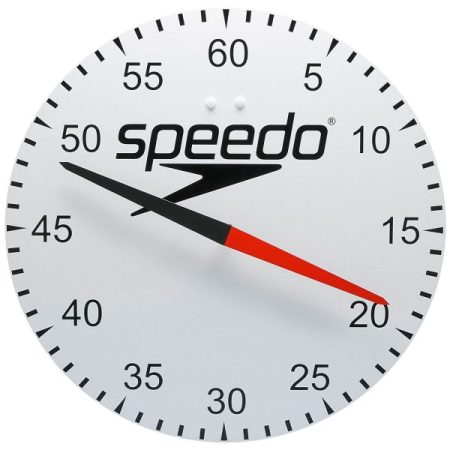This article covers the pace clock’s use and how it can help you be a better athlete and more confident in your swim sessions.
We’ve all seen the magical pace clock sitting spinning around to itself in pools across the land. You may have even looked at it and wondered, ‘Their clock is broken; there’s not even a minute hand, let alone an hour hand!’
They are probably one of, if not the most important, piece of kit on poolside; most of us tend to jump in and smash our set out, get out and go home (some might even shower, but that removes the great smell of chlorine!). This is fine, but you really miss out on controlling your workouts well and developing your fitness even quicker.
Ok, smart arse, how in the hell do I use it?
Pace clocks constantly run so an athlete can track their rest intervals, overall rep time and leaving a set time between others in the lane. Most clocks you will find in centres across the UK are the basic analogue type that normally has one hand (one side red and one black or green) that complete a full circle of the clock face in one minute (60 seconds). The face is split as a normal clock face, so big hashes at 12, 3, 6 and 9 o’clock and smaller five-second hashes filling in the spaces in between.

The simplest way to work a pace clock is first to choose a hand (red, black or green), then use 12 o’clock or ‘top’ as your starting point. Set off on your rep when the hand hits the top and swim your swim. When you return, check the time on the clock, giving you the seconds for that rep minus your minutes depending on how many metres you are doing. For example, you are swimming 50m and return finish the rep with the red hand on 50 seconds on the clock, that 50m took 50 seconds. If, however, you are swimming a 100m rep and return on 40 seconds on the clock, your rep will have taken 1 minute and 40 seconds as the hand will have gone round the clock once during the swim due to the distance covered. Ideally, you need to know your average 25, 50 and 100 times to enable you to work out how many minutes will have passed during your longer reps.
Yes, there’s more you can do with this archaic device! You can use it to time swim intervals, and this means that if you normally work off +10 or +15 rest intervals, you can look at the clock when you come in and set of 10 seconds later or 15, whichever is your fancy. However, this may cause some issue if you are coming in at odd times, like 43 seconds or 57, the maths starts to become difficult. For this reason, most swimmers and coaches will use turn around times. This essentially means that after a set amount of time, you will set off swimming again, so for example, let us use 1.45 as the turnaround, so every 1 minute and 45 seconds, you will start to swim again no matter how much or little rest you have had. Let me give you a real-world example:
Coach: ‘The next set is 4×100 off 1.45 red top with 10 seconds between each swimmer, in 3, 2, 1, GO!’
Translation: 4x100m reps leaving for the first one (if you are the first swimmer) as the red hand hits 12 o’clock for the first swimmer (we’ll assume you swim 1.30 for 100m), which means you come in at 6 o’clock or 30 seconds on the clock and start swimming again when it hits quarter to or 9 o’clock. This then means on the next rep, and you will leave again 1.45 from quarter to or 9 o’clock, which is bottom or 6 o’clock and so on for the following reps. If you are number 2 in the lane, you leave a 10-second gap after the first swimmer leaves and go off that as your ‘top’, so 10 past becomes 12 o’clock. Check the list below to give you a clearer picture of how this works in practice.
| Rep Number | Swimmer 1 on Red Top | Swimmer 2 on Red 10 Past | Swimmer 3 On Red 20 Past |
|---|---|---|---|
| 1 | Top (0) | 10 past (10) | 20 past (20) |
| 2 | Quarter to (45) | 5 to (55) | 5 past (5) |
| 3 | Bottom (30) | 20 to (40) | 10 to (50) |
| 4 | Quarter past (15) | 25 past (25) | 25 to (35) |
There you go; hopefully, this has made it a little more clear for you to get out there and start having a go at using a pace clock and not just relying on your Garmin or others in your lane
Take a look at what TCC has to offer and build your fitness with us